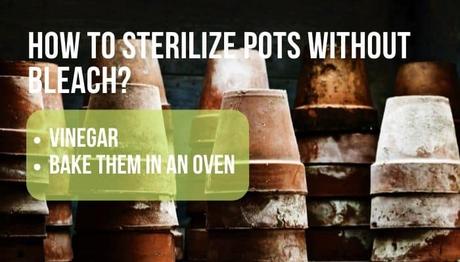Once the warmer weather is around the corner, you’re probably considering reusing the old pots in the new gardening season. But, debris has probably accumulated inside the pots, and therefore you should sterilize them before potting a plant in there. Proper sterilization doesn’t take much effort, yet it’s essential for the success of the potted plant.
Importance of Sterilizing Old Pots
Firstly, if the plant from the previous seasons has carried any diseases, they’ll be transmitted to the new one. It’s very likely for the leftover soil to have harbored bacteria that’ll infect your new plant. Moreover, the salt that builds up from the soil inside the pot can dehydrate the plant stems. For this reason, you should thoroughly clean old pots before reusing them.
In this case, the most commonly used disinfectant is household bleach. However, as you probably know, it’s a chemical, and therefore not the best option. Luckily, some safer alternatives will go a long way towards sterilizing plant pots as well.
Chemical-Free Ways to Sterilize the Plant Pots

Sterilizing pots is a straightforward process. Here are some chemical-free, yet very efficient and affordable sanitizing methods to kill the pathogens that accumulate on the pot surface. But, considering the fact that not all the pots are made of the same material, you should determine in the first place what way will work best for your garden pot.
No matter which of the following methods of sterilization you’ll go with, always start by physical removal of any loose dirt from the pot. Wash the inside with hot water and scrub the surface with a brush. But then again, even clean, the pots aren’t germ-free just yet.
Cleaning Plant Pots with Vinegar
Give your pots an acid bath. Vinegar is an inexpensive, environmentally-friendly option for pot sterilization, and it won’t affect your skin into the bargain. This method works for both plastic and clay pots.
- Completely submerge the pots in a mixture of 1 part water and 1 part white vinegar.
- Leave them for a couple of hours.
- Scrub the pots with a rag to remove any dirt left.
- Rinse with cold water.
- Let them air dry.
For really tough crusty buildup, go with a stronger vinegar solution.
- Wipe the stains with a ¾ strength vinegar-water solution using a sponge.
- Leave them under a wet cloth for an hour.
- Rinse and scrub.
Note: If it’s clay pots you’re cleaning, soak them in water first.
Bake the Pots in the Oven
Heat-sterilize your clay pots following the steps:
- Preheat the oven to 220 °F.
- Put the pot onto a baking sheet, then in the oven.
- Leave it for an hour.
- Turn the oven off, wait for the pot to cool completely, then take it out.
Never take the pots out until they’re completely cool, there’s a risk of breaking them.
Note: This method works with clay pots only.
How to Clean Flower Pots with Bleach
If you’ve decided to go with the bleach, after all, follow the steps below.
- Soak the pots in a mixture of 1 part chlorine bleach and 9 parts cold water for at least 30 minutes.
- Give them a good rinse. Clay pots, unlike the plastic ones, are porous, so they will most likely absorb bleach. Hence, soak them in a bucket of clean water as well.
- Let the pots air dry in the sun to prevent bacterial growth.
Warning: Wear protective gloves to prevent from getting into contact with chemicals and pathogens.
Storing Pots for Winter
On the other hand, you can make your spring planting much easier if you thoroughly clean your pots at the end of the season prior to storing. This way, you’ll prevent any pests and diseases from surviving the winter.
Start by emptying the garden pots. Dispose of the dead plants and store the potting soil if it’s still in good condition. Then, sterilize them using some of the abovementioned methods.
Plastic Pots
Now that the plastic pots are free of germs, they’re ready to store. Seeing that they’re capable of withstanding temperature changes, you can store them outside. However, make sure to cover them first.
Clay Pots
When it comes to clay pots, they should never be left outside during winter. Given that they’re porous, they’ll retain some moisture, which will freeze and expand once the temperatures drop below freezing. Consequently, the pots will crack. Therefore, it’s for the best to wrap each pot in a newspaper and store them indoors.
FAQs
⚖️What’s the difference between disinfection and sterilization?Both disinfection and sterilization are decontamination processes – that is, removal of contaminants. The main difference between them is that disinfection is a process of reducing or eliminating pathogens only, whereas sterilization is a process of killing all microorganisms from objects and surfaces.
⚠️How to disinfect pots with hydrogen peroxide?Because of its antimicrobial properties, hydrogen peroxide (H2O2) can be used for pot disinfection. With that said, spray the pots with 6%-9% of peroxide solution. This will reduce the risk of contamination from pathogens. If you’re going with a stronger hydrogen peroxide solution, use it cautiously, seeing that it can burn skin and plant tissues.
🗑️How do you manage waste broken pots?When a plastic garden pot is broken, it can’t be recycled. Therefore, if it’s no longer usable, it should go right in your trash bin. On the other hand, if a clay pot breaks, it can serve for other purposes in many unique ways. For instance, use its broken pieces as drainage by placing them at the bottom of other pots, or make some decorative accessories and mosaics out of its pieces.

